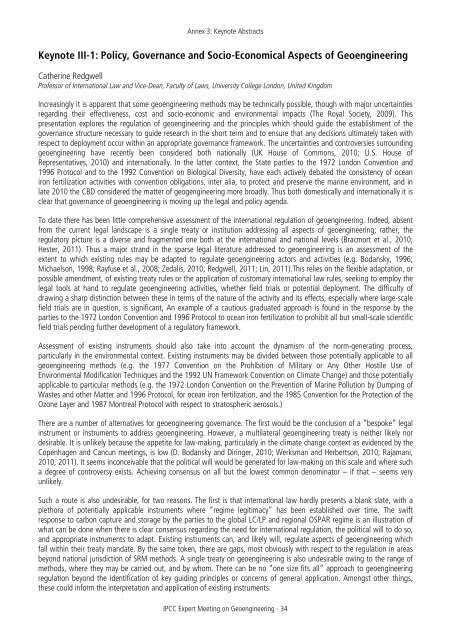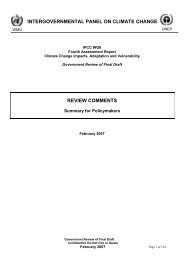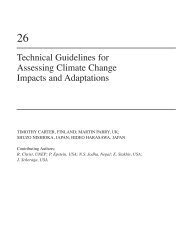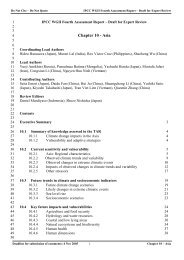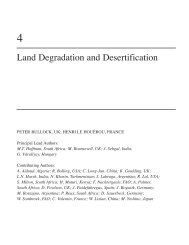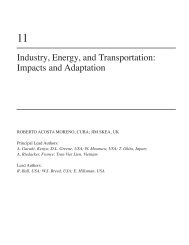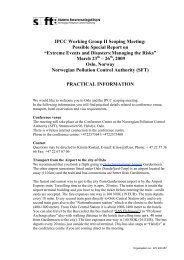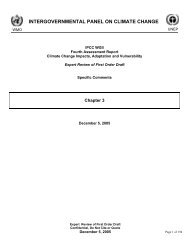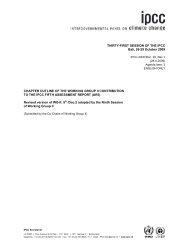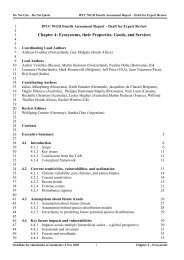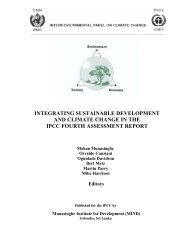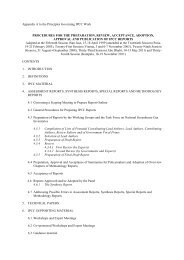IPCC Expert Meeting on Geoengineering
IPCC Expert Meeting on Geoengineering
IPCC Expert Meeting on Geoengineering
Create successful ePaper yourself
Turn your PDF publications into a flip-book with our unique Google optimized e-Paper software.
Annex 3: Keynote Abstracts<br />
Keynote III-1: Policy, Governance and Socio-Ec<strong>on</strong>omical Aspects of <strong>Geoengineering</strong><br />
Catherine Redgwell<br />
Professor of Internati<strong>on</strong>al Law and Vice-Dean, Faculty of Laws, University College L<strong>on</strong>d<strong>on</strong>, United Kingdom<br />
Increasingly it is apparent that some geoengineering methods may be technically possible, though with major uncertainties<br />
regarding their effectiveness, cost and socio-ec<strong>on</strong>omic and envir<strong>on</strong>mental impacts (The Royal Society, 2009). This<br />
presentati<strong>on</strong> explores the regulati<strong>on</strong> of geoengineering and the principles which should guide the establishment of the<br />
governance structure necessary to guide research in the short term and to ensure that any decisi<strong>on</strong>s ultimately taken with<br />
respect to deployment occur within an appropriate governance framework. The uncertainties and c<strong>on</strong>troversies surrounding<br />
geoengineering have recently been c<strong>on</strong>sidered both nati<strong>on</strong>ally (UK House of Comm<strong>on</strong>s, 2010; U.S. House of<br />
Representatives, 2010) and internati<strong>on</strong>ally. In the latter c<strong>on</strong>text, the State parties to the 1972 L<strong>on</strong>d<strong>on</strong> C<strong>on</strong>venti<strong>on</strong> and<br />
1996 Protocol and to the 1992 C<strong>on</strong>venti<strong>on</strong> <strong>on</strong> Biological Diversity, have each actively debated the c<strong>on</strong>sistency of ocean<br />
ir<strong>on</strong> fertilizati<strong>on</strong> activities with c<strong>on</strong>venti<strong>on</strong> obligati<strong>on</strong>s, inter alia, to protect and preserve the marine envir<strong>on</strong>ment, and in<br />
late 2010 the CBD c<strong>on</strong>sidered the matter of geogengineering more broadly. Thus both domestically and internati<strong>on</strong>ally it is<br />
clear that governance of geoengineering is moving up the legal and policy agenda.<br />
To date there has been little comprehensive assessment of the internati<strong>on</strong>al regulati<strong>on</strong> of geoengineering. Indeed, absent<br />
from the current legal landscape is a single treaty or instituti<strong>on</strong> addressing all aspects of geoengineering; rather, the<br />
regulatory picture is a diverse and fragmented <strong>on</strong>e both at the internati<strong>on</strong>al and nati<strong>on</strong>al levels (Bracmort et al., 2010;<br />
Hester, 2011). Thus a major strand in the sparse legal literature addressed to geoengineering is an assessment of the<br />
extent to which existing rules may be adapted to regulate geoengineering actors and activities (e.g. Bodansky, 1996;<br />
Michaels<strong>on</strong>, 1998; Rayfuse et al., 2008; Zedalis, 2010; Redgwell, 2011; Lin, 2011).This relies <strong>on</strong> the flexible adaptati<strong>on</strong>, or<br />
possible amendment, of existing treaty rules or the applicati<strong>on</strong> of customary internati<strong>on</strong>al law rules, seeking to employ the<br />
legal tools at hand to regulate geoengineering activities, whether field trials or potential deployment. The difficulty of<br />
drawing a sharp distincti<strong>on</strong> between these in terms of the nature of the activity and its effects, especially where large-scale<br />
field trials are in questi<strong>on</strong>, is significant, An example of a cautious graduated approach is found in the resp<strong>on</strong>se by the<br />
parties to the 1972 L<strong>on</strong>d<strong>on</strong> C<strong>on</strong>venti<strong>on</strong> and 1996 Protocol to ocean ir<strong>on</strong> fertilizati<strong>on</strong> to prohibit all but small-scale scientific<br />
field trials pending further development of a regulatory framework.<br />
Assessment of existing instruments should also take into account the dynamism of the norm-generating process,<br />
particularly in the envir<strong>on</strong>mental c<strong>on</strong>text. Existing instruments may be divided between those potentially applicable to all<br />
geoengineering methods (e.g. the 1977 C<strong>on</strong>venti<strong>on</strong> <strong>on</strong> the Prohibiti<strong>on</strong> of Military or Any Other Hostile Use of<br />
Envir<strong>on</strong>mental Modificati<strong>on</strong> Techniques and the 1992 UN Framework C<strong>on</strong>venti<strong>on</strong> <strong>on</strong> Climate Change) and those potentially<br />
applicable to particular methods (e.g. the 1972 L<strong>on</strong>d<strong>on</strong> C<strong>on</strong>venti<strong>on</strong> <strong>on</strong> the Preventi<strong>on</strong> of Marine Polluti<strong>on</strong> by Dumping of<br />
Wastes and other Matter and 1996 Protocol, for ocean ir<strong>on</strong> fertilizati<strong>on</strong>, and the 1985 C<strong>on</strong>venti<strong>on</strong> for the Protecti<strong>on</strong> of the<br />
Oz<strong>on</strong>e Layer and 1987 M<strong>on</strong>treal Protocol with respect to stratospheric aerosols.)<br />
There are a number of alternatives for geoengineering governance. The first would be the c<strong>on</strong>clusi<strong>on</strong> of a “bespoke” legal<br />
instrument or instruments to address geoengineering. However, a multilateral geoengineering treaty is neither likely nor<br />
desirable. It is unlikely because the appetite for law-making, particularly in the climate change c<strong>on</strong>text as evidenced by the<br />
Copenhagen and Cancun meetings, is low (D. Bodansky and Diringer, 2010; Werksman and Herberts<strong>on</strong>, 2010; Rajamani,<br />
2010, 2011). It seems inc<strong>on</strong>ceivable that the political will would be generated for law-making <strong>on</strong> this scale and where such<br />
a degree of c<strong>on</strong>troversy exists. Achieving c<strong>on</strong>sensus <strong>on</strong> all but the lowest comm<strong>on</strong> denominator – if that – seems very<br />
unlikely.<br />
Such a route is also undesirable, for two reas<strong>on</strong>s. The first is that internati<strong>on</strong>al law hardly presents a blank slate, with a<br />
plethora of potentially applicable instruments where “regime legitimacy” has been established over time. The swift<br />
resp<strong>on</strong>se to carb<strong>on</strong> capture and storage by the parties to the global LC/LP and regi<strong>on</strong>al OSPAR regime is an illustrati<strong>on</strong> of<br />
what can be d<strong>on</strong>e when there is clear c<strong>on</strong>sensus regarding the need for internati<strong>on</strong>al regulati<strong>on</strong>, the political will to do so,<br />
and appropriate instruments to adapt. Existing instruments can, and likely will, regulate aspects of geoengineering which<br />
fall within their treaty mandate. By the same token, there are gaps, most obviously with respect to the regulati<strong>on</strong> in areas<br />
bey<strong>on</strong>d nati<strong>on</strong>al jurisdicti<strong>on</strong> of SRM methods. A single treaty <strong>on</strong> geoengineering is also undesirable owing to the range of<br />
methods, where they may be carried out, and by whom. There can be no “<strong>on</strong>e size fits all” approach to geoengineering<br />
regulati<strong>on</strong> bey<strong>on</strong>d the identificati<strong>on</strong> of key guiding principles or c<strong>on</strong>cerns of general applicati<strong>on</strong>. Am<strong>on</strong>gst other things,<br />
these could inform the interpretati<strong>on</strong> and applicati<strong>on</strong> of existing instruments.<br />
<str<strong>on</strong>g>IPCC</str<strong>on</strong>g> <str<strong>on</strong>g>Expert</str<strong>on</strong>g> <str<strong>on</strong>g>Meeting</str<strong>on</strong>g> <strong>on</strong> <strong>Geoengineering</strong> - 34


